Beeing Responsible While Starting a Beehive
by Christina Tyler Wenks, Fairfax Master Gardener
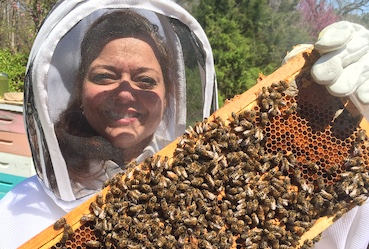 We like pollinators and we like to eat. If you like to eat, you like pollinators, who are responsible for one in every three bites of food. Some argue that number is higher. Many gardeners creating pollinator-friendly spaces also consider installing beehives and reap sweet rewards.
We like pollinators and we like to eat. If you like to eat, you like pollinators, who are responsible for one in every three bites of food. Some argue that number is higher. Many gardeners creating pollinator-friendly spaces also consider installing beehives and reap sweet rewards.
Virginia is home to hundreds of types of native bees. Although all collect food for themselves and offspring, the only bee that produces food that humans can harvest and eat is the European honey bee, or Apis mellifera.
In recent years, Virginia’s bee populations dropped to unsustainable rates and several native bee varieties teetered on extinction. Beekeepers helped maintain viable honey bee populations through winters.
The decision to install a beehive should include careful considerations.
Determine the right site
Choose a site that is sunny, near a water source and has a wind break but good airflow. Fairfax County requires water within 50 feet (15 m) of the hive entrance.
Bees do not discriminate between water sources and will beeline to nearby ponds, creeks, bird baths and swimming pools. While considering a water source, assess depth of water and whether bees can sit on an edge while drinking. A neighbor’s chlorinated or salt-water pool becomes the last stop for thousands of hive residents who seek to sip, resulting in a pool filter full of decaying bugs.
Providing rocks, floating sticks or corks in a bird bath allow bees to sip without drowning, and birds can partake, too. Nature and nurture may collide when bees become a bird’s lunch, but a small percentage of the hive is expected not to return home at the end of the day. A healthy hive with a laying queen still thrives with daily attrition.
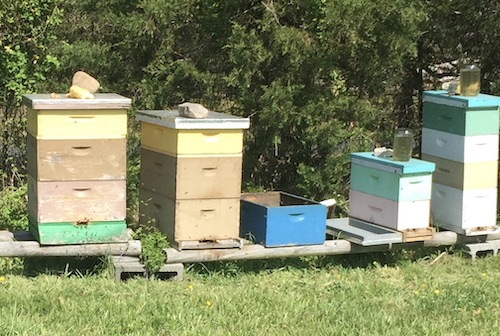
Bee aviary and proper surroundings
Bees need “bee space” or several feet in front to their hives to set their natural GPS. Orientation flights are a bee’s first day of flight and look like giant crazy eights in front of a hive. This is when they learn to recognize where they live and how to get home.
Bees forage within a few miles of home and return to their hive when their pollen pouches are full. Beekeepers never know exactly where their bees are collecting nectars and pollens, but trees, plants and grasses blooming within a few mile radius is a clue.
Protect the site from people and critters
Place hives on blocks to provide air flow and keep moisture out. Elevating hives 18 inches (45 cm) above the ground discourages nocturnal critters seeking a protein food source of bee brood. In these sites, threatened bees attack underbellies of predators before a hive can be entered or destroyed. Bears may enjoy honey, but bee-brood protein packs much more nutritional value.
Consider high shrubbery or fencing near the hive so bees must fly up and away from the hive. Fencing might deter curious pets. Protection from bears may be necessary in some locations.
Home owner associations may require signage to alert neighbors to seek caution when nearby.
Choose equipment
Tools needed include a smoker, veil, hive tool and light-colored smooth clothing. Deciding which beehive type or woodenware, such as a Langstroth or top-bar hive style, is critical to time and monetary investment as well as hive management.
The basic beehive has a top that protects bees from moisture and a bottom that often contains a screen for ventilation, and a number of boxes called supers that contain frames where bees build wax comb that houses brood, packed pollen and honey.
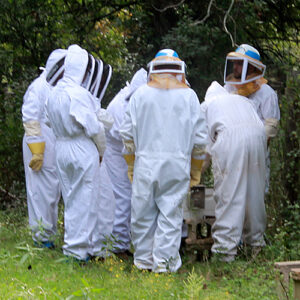
Personal beekeeping equipment
Consider clothing choices. Bees hide or disguise themselves in black and dark spaces, so they naturally fly and crawl into dark spaces for protection — such as when the hive is opened by a beekeeper and bees feel the need to protect their hive or home. This is why beekeepers wear white or light colors.
For some, a protective jacket and denim pants are not enough protection from stingers, and a full-body beekeeping suit may be best. Leather gloves are thick and durable, but some beekeepers opt for thinner rubber gloves.
Fairfax County limits the number of allowed hives based on a parcel’s square footage. Virginia Cooperative Extension recommends fewer than four hives per half acre.
Personal experience, beekeeper friends and classmates frequently demonstrate that two hives survive better than one — in the event of one hive absconding, dying during dearth — a second hive can be split. The hives aid each other during predator defense, such as wasps trying to invade and rob honey.
Honey extractors are available for purchase but may be available for a day through local bee clubs, such as the Northern Virginia Beekeeping Association or Fairfax Beekeepers.
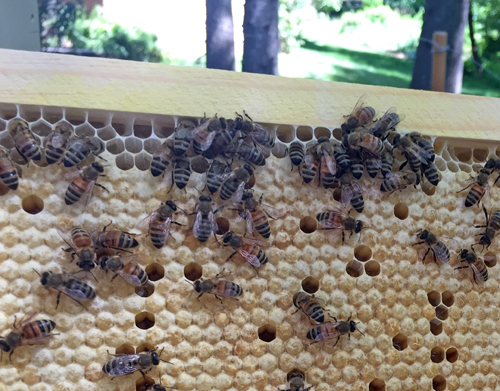
Capped bee brood — or pupating bees
Choose the right bee and purchase locally
Like people, culture influences bee behaviors. Choose the right bee for the hive site. Italian bees, or Apis mellifera ligustica, are considered gentle, fast-growing, reluctant to swarm and disease resistant. Carniolans, or Apis mellifera carnica, are also considered gentle and can overwinter in small quantities and are thrifty with honey stores. Other bee types are available. Consider characteristics for the site’s weather conditions and individual beekeeping needs.
Purchase queens from local beekeepers. Purchasing queens and nucleus colonies, known as “nucs,” online from far away states can result in genetics that may not be as regionally compatible.
Education
Some gardeners hoping to nurture nature place hives in their gardens and let bugs tend to themselves. Understanding bee biology and behavior results in more successful bee management.
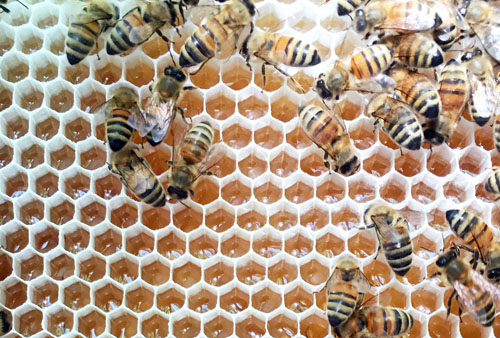
Fresh beeswax
Bees are like butterflies. The pupae hatches from an egg and transfigures into an insect with wings. Those bee stages are contained within a single wax cell hidden from the outside world. Baby bees are called brood. A queen usually lays eggs in the hive’s bottom supers. Honey is placed on top and around the edges as a food source and insulation.
Bee hives are susceptible to disease and invading pests. Many beekeepers believe well-intended gardeners-turned-beekeepers benefit from beekeeping classes to better manage hives in times of dearth and bitter cold, recognize and treat diseases that weaken colonies and harvest honey in ways so wax can be reused by bees and more energy is spent on honey production. Consistent hive management mitigates colony collapse and improves genetics of all local bees.
Bees make enough food for themselves and do not intentionally generate honey in quantity that humans want. Skilled beekeepers responsibly manage a hive by leaving enough honey for the bees while harvesting some for people, too.
Resources
Beginning Beekeeping Presentations, Virginia Cooperative Extension
Virginia Beekeeping Laws, Virginia Law Library
Northern Virginia Beekeeping Zoning Regulations, Virginia County Codes
Northern Virginia Beekeeping Association
Fairfax County Zoning Ordinance